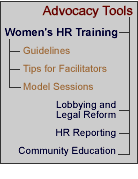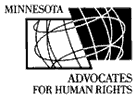|
|
CONDUCTING EXERCISESThe purpose of the training exercises and activities is to facilitate the learning process. For the training exercises to be successful they should meet the following requirements: The exercises should:
Therefore, besides a general training plan, it is necessary to develop a more detailed plan of how each exercise will be conducted. While planning an exercise, it is advisable to take in account priorities, i.e. all important issues should be addressed at the beginning of the session, secondary issues may be combined and summarized for the remainder of the time. Each exercise is divided into specific consistent logical steps: 1) Facilitators’s introduction leads the training group into the main topic of the exercise and sets the guidelines. 2) Then, through various techniques, the facilitators gradually facilitate reaching the goal of the exercise. 3) The exercise concludes with the Facilitator’s commentary or debriefing, which allows the training team to summarize the results of the discussion, briefly review the group’s accomplishments and emphasize the most important points regarding the subject of the exercise. The facilitator’s commentary is a response to the objectives set forth for the exercise. The training team should share a very clear vision of the results they seek to achieve with the group, as well as the techniques that will be used in the process. Interactive methodologies facilitate attaining the objective of the exercise, as well as the free exchange of thoughts and feelings after each exercise. However, with some interactive methodologies, such as a group discussion, it is important that the facilitator focus the group’s attention on the main issue and prevent any irrelevant issues from being discussed. It is advisable to determine the parameters for conducting the group discussion. The parameters will depend on the time remaining for each exercise (it is particularly necessary to narrow the topic of discussion when time is short) or on the group composition (professional affiliation of group members, their education, age, etc.). Such planning helps facilitators make their points more effectively and avoid controversial arguments. Some flexibility is necessary, however, to ensure active participation, otherwise the group’s grasp of the subject matter may be insufficient and they will not master any new information. The Tips for Facilitators page offers some advice on how to evaluate the effectiveness of training exercises and activities. What is a Training | Needs Assessment | Goals and Objectives Organizing a Training Workshop | Preparing the Training Program | Conducting Exercises | Training Methods | Tips for Facilitators | [Model Sessions] | Final Remarks |
| Home | Contact | Feedback | Disclaimer |

